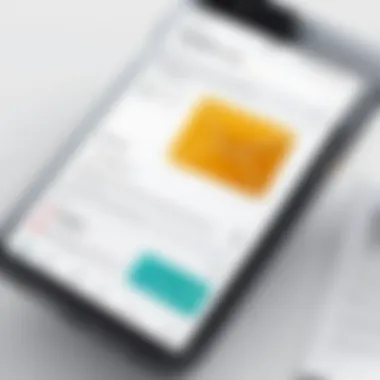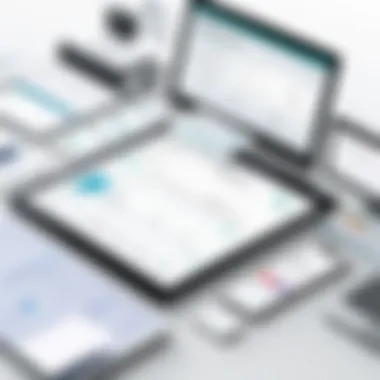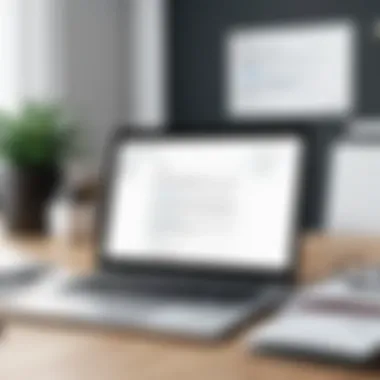Maximizing Email Receipts in Expensify for Efficiency


Intro
Email receipts play a critical role in managing expenses, especially in today's fast-paced business environment. Expensify has integrated a robust email receipt feature, which offers significant benefits in streamlining the expense management process. For professionals, decision-makers, and IT leaders, understanding this functionality is crucial to optimizing financial workflows. This article delves into the core features, advantages, and challenges associated with using email receipts within Expensify.
Key Software Features
Essential functionalities
Expensify's email receipt functionality provides users with a simple means to track expenses without manual data entry. Users can forward receipts directly to an Expensify email address. The software automatically extracts important details like date, vendor, and amount, which enhances accuracy and saves time.
- Automatic data extraction reduces human error.
- Integration with other financial tools allows seamless data flow.
- Mobile app support enhances usability, enabling users to capture receipts on the go.
Advanced capabilities
Beyond basic features, Expensify offers advanced functionalities that enhance its appeal. Users can categorize expenses automatically based on the receipt's contents. Moreover, there is an option to attach receipts to specific reports, which simplifies reimbursement requests.
- Smart categorization improves organization.
- Report linkage streamlines reimbursement processing.
- Multi-currency support addresses international users’ needs.
Benefits of Using Email Receipts in Expensify
Leveraging email receipts can lead to enhanced operational efficiency. By automating data entry and facilitating organized record-keeping, finance teams can focus on higher-level tasks. Additionally, this feature aids in maintaining compliance with internal and external audit requirements.
"Automating the expense tracking process transforms how organizations manage their financials, leading to substantial time and cost savings."
Common Issues and Resolutions
Though effective, some users may encounter challenges when utilizing email receipts. Common issues include:
- Email not recognized by Expensify: Ensure the correct email address is used, and the account is properly set.
- Receipts missing critical information: Sometimes, receipts may lack important data. Users should ensure the receipt is clear and legible.
To resolve these problems, users may follow guidelines provided in Expensify’s help center. Regular updates to the application can also minimize such disruptions.
Culmination
Using email receipts in Expensify is a valuable tool for professionals and organizations aiming to enhance their financial management processes. The blend of automated features significantly reduces administrative burdens and improves accuracy in expense tracking. Ultimately, mastering this functionality can lead to a more streamlined and efficient reimbursement process for all involved.
Intro to Expensify and Email Receipts
In today’s fast-paced business environment, managing expenses efficiently is critical. This is where Expensify comes into play. The integration of email receipts within this platform not only simplifies tracking but also enhances the accuracy of financial reporting.
Understanding Email Receipts
Email receipts serve as a digital alternative to traditional paper receipts. They allow users to capture and store proof of purchase electronically. By forwarding receipts directly to Expensify, users eliminate the tedious process of manual entry and filing. This digital approach ensures that all expenses are documented and easily accessible for review and analysis.
The advantages of utilizing email receipts are numerous. They provide a streamlined method for tracking expenditures, reduce clutter, and minimize the risk of losing important documentation. Additionally, email receipts enhance the accuracy of the expense reporting. Each transaction is logged automatically, drastically reducing human error that can occur with manual processes.
Expensify Overview
Expensify is a cloud-based expense management software that caters to businesses of all sizes. With its user-friendly interface, it provides a wide range of features to make expense tracking efficient. From receipt scanning to generating comprehensive financial reports, Expensify stands out in the market.
One of the key features of Expensify is its ability to integrate seamlessly with various accounting tools. This aids financial teams in maintaining clarity in their records. Users can also set up expense policies, ensuring compliance and reducing reimbursement disputes. The platform supports multiple currencies, making it beneficial for international transactions.
In summary, understanding how email receipts operate within Expensify is vital. It helps users leverage this technology for enhanced expense management, leading to greater financial oversight and improved operational efficiency.
Integration of Email Receipts in Expensify


The integration of email receipts into Expensify is essential for fostering productivity within expense management. This process simplifies how organizations track and manage their finances. By allowing users to send receipts via email directly into the Expensify platform, relevant data is captured efficiently. This helps eliminate the tedious task of manual data entry, which can often lead to errors and inconsistencies.
Moreover, integrating email receipts means you can capture transactions in real-time. This immediacy ensures that all expenses are documented promptly. This could lead to a more accurate financial picture, particularly for decision-makers who depend on current data for analysis.
Setting Up Email Receipts
Setting up email receipts within Expensify is a straightforward process. First, users need to log into their Expensify accounts. After accessing the settings menu, the option for email receipts can be activated. It may be beneficial to familiarize oneself with setup details via the official Expensify documentation. A good initial step is ensuring that notifications are allowed for email receipts. This will enable users to receive confirmations when receipts are sent successfully.
With a few clicks, users can set preferences regarding how the receipts should be processed once they arrive in Expensify. For professionals, properly configuring these preferences avoids complications later in the expense tracking process.
Linking Email Accounts
Linking email accounts to Expensify is crucial for the seamless flow of receipt data. Users can link multiple email accounts to receive receipts from various sources. To link accounts, users navigate to their account settings and select the option to add an email address.
Once added, users should send a test receipt to verify that messages are received correctly. It is important to ensure that the email address is entered correctly to avoid miscommunication. Correct linking of these accounts is not just about convenience; it also enhances the accuracy of records. Each email receipt that is accurately linked can lead to a more reliable database of expenses.
Expensify's Email Receipt Address
Every Expensify user is assigned a unique email address specifically for receiving receipts. This address can be found in the settings of the user’s profile. It is essential for users to understand that all receipts sent to this address are automatically processed by Expensify.
Maintaining the confidentiality of this email is important as it protects sensitive expense information. Users must be cautious when sharing this address to reduce the risk of unintended access. Additionally, sending receipts directly to this address allows Expensify to extract critical data, making the expense report generation much more efficient.
In summary, the integration of email receipts in Expensify paves the way for comprehensive expense management, granting enhanced accuracy, efficiency, and convenience.
Benefits of Using Email Receipts
Email receipts are becoming increasingly crucial for modern businesses that rely on digital solutions. This section addresses the specific merits of using email receipts in Expensify. Decision-makers and IT professionals should understand how these benefits contribute to enhanced expense management strategies.
Efficiency in Expense Tracking
Utilizing email receipts in Expensify leads to notable improvements in efficiency when it comes to tracking expenses. Instead of manually entering receipt information, users can simply forward email confirmations to Expensify. This automatic import saves significant time that can be redirected towards more strategic tasks. Automated systems minimize human error, which is common in manual data entry processes. Additionally, users can categorize expenses immediately, facilitating easier access for auditing and reporting.
Studies show that automation in financial processes can reduce the time spent on administrative tasks by up to 70%.
Accuracy in Financial Reporting
Another significant advantage of email receipts lies in their ability to enhance the accuracy of financial reporting. With receipts directly linked to a user's account, data integrity is substantially improved. Email receipts, which often contain vital transaction details, are less prone to loss or misplacement compared to physical receipts. This ensures that the reported figures align closely with actual expenditures, which is essential for compliance, tax reporting, and overall transparency.
Furthermore, with the rise of real-time data processing, having reliable electronic receipts increases the speed and accuracy of monthly or quarterly financial reports. This precision is important for stakeholders who rely on trustworthy data to make informed decisions.
Simplification of Record-Keeping
Email receipts simplify the process of record-keeping, which can often become a tedious task for businesses. By centralizing all receipts within Expensify, companies can reduce the clutter of physical documents. Digital storage is not only more manageable but also secure. Users can easily search for past receipts using keywords or filter by categories, which is often not an option with physical records.
This approach to record-keeping allows businesses to maintain a clean, organized financial history that is easily accessible when needed. For audits or reviews, having everything in one place streamlines the process significantly.
Challenges with Email Receipts
Using email receipts in Expensify can streamline various aspects of expense management. However, there are significant challenges that users encounter. Recognizing these challenges is crucial for optimizing the use of this feature. Properly addressing issues related to email receipts not only safeguards the accuracy of financial records but also enhances the overall user experience.
Common Issues Faced by Users
Many users report some recurring difficulties when using email receipts. These issues can inhibit effective expense tracking and may lead to frustration. Common problems include:
- Receipt Not Captured: Sometimes, an email receipt fails to upload into the system. This could stem from incorrect email forwarding or server glitches.
- Data Extraction Errors: Occasionally, Expensify struggles to extract data from receipts, resulting in missing or incorrect information. This can lead to mistakes in expense reporting.
- Email Format Compatibility: Some users find that certain formats or attachments do not get recognized, causing issues with processing receipts.
- Spam Filters: Emails may unintentionally get routed to spam folders. If this occurs, receipts do not securely reach the Expensify system.


Understanding these challenges helps users to prepare effectively. It is vital to be aware of the issues at play in order to implement solutions quickly.
Troubleshooting Tips
To address the common problems associated with email receipts, users can follow several troubleshooting strategies. Here are some actionable tips:
- Check Email Settings: Ensure the email account linked to Expensify is properly configured. Review forwarding rules and verify that the correct email address is being used.
- Verify Format: Make sure that receipts are sent in formats that Expensify recognizes. PDF is usually preferred, while images can sometimes present issues depending on their size or quality.
- Manual Uploading: If emails do not work, manually uploading receipts as a temporary measure can be effective. Users can scan or take clear pictures of the receipts to upload.
- Regular Monitoring: Users should routinely check spam folders to catch any receipts that may have been misrouted. Adjust spam filter settings if necessary.
- Contact Support: If persistent problems occur, reaching out to Expensify's support team can provide guidance tailored to specific issues.
"Anticipating and addressing common challenges with email receipts can significantly enhance efficiency and user satisfaction."
By following these strategies, users can mitigate the challenges they face when implementing email receipts and make the process more efficient and error-free.
Best Practices for Maximizing Email Receipt Use
To fully leverage the benefits of email receipts in Expensify, adopting best practices is essential. These practices help maximize efficiency and reduce potential issues that can arise during expense reporting. Understanding how to organize receipts effectively and maintain compliance with relevant policies is key for any professional using this tool.
Organizing Receipts Efficiently
Organizing receipts is the cornerstone of effective expense management. When receipts are well-organized, it becomes easier to track expenses and prepare for audits. Expensify offers various features that can enhance organization.
- Labeling Receipts: Always label receipts with appropriate tags. This could include categorizing by project, client, or type of expense. Tags help in quickly identifying the purpose of each receipt.
- Creating Folders: Utilize folders within Expensify to group related receipts. For example, separate folders for travel expenses, office supplies, and client meetings can aid in clarity and expedience during reviews.
- Regular Reviews: Set a regular schedule to review and organize receipts. This could be weekly or monthly, depending on the volume of expenses. By keeping receipts current, you simplify the reconciliation process and avoid last-minute chaos.
Effective organization minimizes confusion, reduces stress, and increases the accuracy of financial reports.
Maintaining Compliance with Policies
Compliance with corporate and tax policies is critical when using email receipts. Not adhering to these standards can lead to discrepancies or issues with reimbursements and audits. Expensify can facilitate this, but users must stay vigilant.
- Understand Company Policies: Familiarize yourself with the expense policies of your organization. Knowing what is eligible for reimbursement helps to avoid submitting ineligible receipts.
- Store Receipts Properly: Ensure that emails and receipts are archived in line with company compliance standards. Understanding the duration for which these records must be kept is necessary to stay compliant.
- Regular Training: Engage in regular training or informational sessions regarding policies. Policies can change, and being updated ensures compliance while avoiding pitfalls.
Adhering to these compliance measures not only prevents issues but also builds a culture of accountability within the organization.
"Efficiency and compliance are not just goals; they are critical components of successful expense management."
By implementing these best practices in organizing receipts and maintaining compliance, users can vastly improve their experience with email receipts in Expensify. This structured approach helps professionals seamlessly integrate email receipts into their everyday workflow, enhancing overall productivity.
Comparative Analysis: Email Receipts versus Traditional Methods
In the realm of expense management, the comparison between email receipts and traditional methods is significant for understanding the evolving landscape of tracking finances. Traditional methods, often involving paper receipts and manual entries, present various obstacles that can affect the efficiency and accuracy of expense reporting. With the rise of digital solutions, such as Expensify's email receipts, an evaluation of these two approaches sheds light on their respective advantages and disadvantages.
Time Consumption Analysis
A primary element for consideration in this comparative analysis is time consumption. Traditional methods require several steps that can be time-intensive. Users must physically collect receipts, ensure they are not lost or damaged, and later enter the details into a spreadsheet or expense report. Each of these steps can consume significant time, particularly for professionals who are managing multiple expenses across various transactions.
In contrast, email receipts streamline this process. When a receipt is sent directly to Expensify via email, it is automatically logged into the system. This automation can vastly reduce the time spent on data entry. Users can also easily retrieve past receipts without sifting through piles of paper or folders on their computers.
The difference in efficiency is stark. According to various user testimonials, individuals can save several hours each month by utilizing email receipts instead of traditional methods. This time savings is crucial for busy professionals who can redirect that focus toward strategic tasks.
Cost-Effectiveness Evaluation
Cost-effectiveness is another critical factor when assessing email receipts versus traditional methods. Maintaining a physical record of receipts often involves costs associated with printing, storage, and potentially, lost or faded documents that require re-creation or replacement. Moreover, the manual handling of receipts can increase the risk of errors, which may lead to compliance issues or financial discrepancies that require further resources to correct.
On the other hand, using email receipts eliminates many of these costs. There are no printing requirements, and storage is handled virtually, often in the cloud. This not only reduces material costs but also mitigates the potential for human error during data entry.
Additionally, businesses that adopt email receipts can benefit from quicker reimbursement cycles, which can lead to better cash flow management. Users no longer have to wait for physical receipts to be processed, enabling faster handling of expenses. Companies can therefore allocate their resources more effectively.


"Utilizing email receipts offers clear savings in both time and money, allowing professionals to focus on more critical business tasks instead of chasing down paper trails."
The End
The conclusion of this discussion about email receipts in Expensify encapsulates the vital aspects and benefits of this feature. As businesses increasingly rely on digital tools for financial management, understanding the role of email receipts becomes essential. The integration of email receipts streamlines the expense reporting process, providing a systematic approach to documenting expenses. This ensures that professionals can track their expenditures accurately and in real time.
Recap of Email Receipt Significance
Email receipts serve multiple functions that greatly enhance financial management. They simplify the collection of receipts which can often be cumbersome, helping to mitigate the issue of lost paperwork. By automatically syncing with Expensify, users can focus on key business activities rather than spending time on manual data entry. Moreover, the accuracy of data captured through email receipts minimizes human error in expense reporting
In summary, email receipts hold significance due to their capacity to improve efficiency and accuracy. Businesses adopting this method can enhance their overall fiscal health. It enables seamless expense tracking, leading to more reliable financial reporting.
Future Trends in Expense Management
Looking ahead, several trends regarding email receipts and expense management are likely to emerge. As automation continues to be a dominant force, tools like Expensify may evolve to include more integrated artificial intelligence features. This could streamline the categorization of transactions, further reducing the burden on users. Moreover, there will likely be a push for enhanced data security measures. As companies become more vigilant about data privacy, ensuring that email receipts are managed securely will be paramount.
In addition, the rising trend of remote work will likely necessitate more robust digital solutions. Expensify's email receipts can help support this transition by allowing employees to submit expenses regardless of their location.
Overall, as technology progresses, email receipts will play a critical role in future expense management, reinforcing the foundation for efficient and effective financial operations.
Official Expensify Documentation
The official documentation provided by Expensify is a vital resource for users. It serves as a comprehensive guide detailing functionalities, integration processes, and troubleshooting tactics. This documentation is frequently updated to reflect any changes in the software's features or functionalities. Users can find step-by-step instructions, best practices, and FAQs that cover various aspects of using email receipts within Expensify.
- User Manuals: Detailed manuals are available to guide individuals through complex tasks related to email receipts and overall expense reporting.
- API Documentation: For tech-savvy users, the API documentation helps integrate Expensify with other software tools, enhancing its capabilities.
Utilizing the official documentation ensures that users stay informed and capable of leveraging all the tools at their disposal.
Webinars and Tutorials
Webinars and tutorials offer a practical approach to learning about Expensify. They provide visual and real-time explanations that can be more effective than written guides alone. Users can participate in live sessions or view recorded content at their convenience. These resources often cover various topics, from basic setups to advanced usage techniques.
- Live Interactive Sessions: Users can directly interact with experts, asking questions and clarifying any uncertainties they may have.
- Case Studies: Many webinars include case studies that demonstrate successful implementations of email receipts in various business environments.
By participating in these educational opportunities, users gain valuable insights that enhance their understanding and implementation of email receipt features in Expensify.
"Knowledge is the most valuable asset when navigating software like Expensify. Those who invest time in learning through these resources will find the experience significantly rewarding."
By exploring these additional resources, users can transform their expense management processes, ensuring effective and efficient handling of email receipts.
User Testimonials
User testimonials serve as a crucial component in understanding the practical benefits of email receipts in Expensify. While technical descriptions and feature lists provide insight into the software's capabilities, real-world experiences from users illustrate its impact on daily operations. Testimonials from business professionals and case studies highlight how email receipts improve efficiency, enhance compliance, and solve common financial management challenges. These insights can significantly influence decision-making for potential users considering the software, thereby adding a layer of validation and trust to the application.
Experiences from Business Professionals
In many businesses, professionals share their experiences of utilizing email receipts within Expensify. For instance, Sarah, a finance manager at a mid-sized tech company, observed how implementing email receipts streamlined their expense-reporting process. She mentioned, "Before adopting Expensify, we struggled with manual entries and lost receipts. Now, the email receipts do most of the heavy lifting. I just forward emails, and the tool extracts important data. It is efficient."
Such testimonies establish the value of the email receipt feature in aiding time management and reducing administrative burden. Other professionals have expressed similar sentiments, noting the ease of tracking expenditures directly from their email accounts. With the automated data extraction in Expensify, users can allocate their resources towards more strategic tasks instead of routine invoicing.
Some professionals even highlight the increased accuracy that comes with using email receipts. In particular, John, an accountant, noted that manual error rates dropped significantly since they began using the feature. His statement resonated with others in the field, expressing how automation minimizes human errors in financial documentation.
Case Studies in Expense Management
Case studies are invaluable in showing practical applications of email receipts in real-world business scenarios. For example, a case study involving a consulting firm presented how shifting to digital expense tracking drastically improved their expense management workflow.
The firm, previously reliant on physical invoices and PDFs, faced frequent auditing issues. By switching to Expensify and utilizing email receipts, they achieved:
- A 30% reduction in processing time for expense reports.
- Enhanced accuracy in reporting, which led to a low audit discrepancy rate.
- Improved employee satisfaction, as staff spent less time on tedious paperwork.
Another compelling case focused on a non-profit organization that had to maintain precise budgets for project funding. They incorporated email receipts to ensure compliance with grant requirements. According to their report, "Using email receipts allowed us to substantiate our expenses with greater clarity. We can now provide immediate proof to our funders without the hassle of gathering receipts later."
Overall, these case studies highlight tangible benefits that email receipts in Expensify can provide, such as increased operational efficiency and better compliance with financial regulations. They illustrate the capability of email receipts to resolve common issues faced by organizations, ultimately making the case for Expensify as a choice for businesses aiming to refine their expense management strategies.

